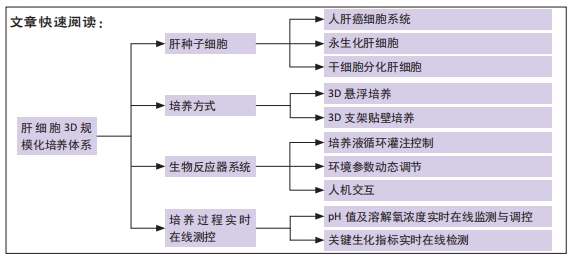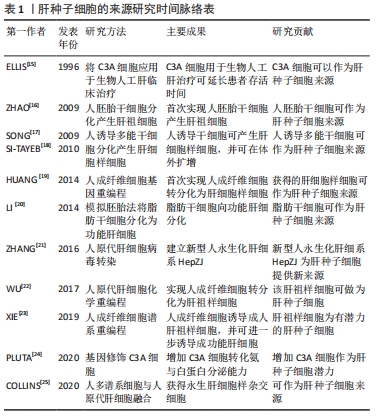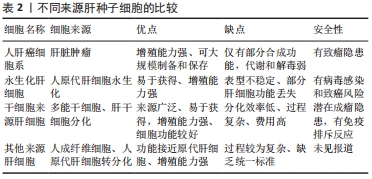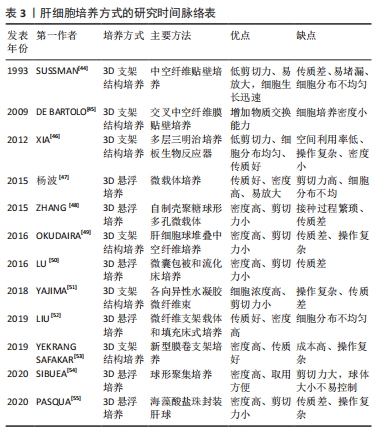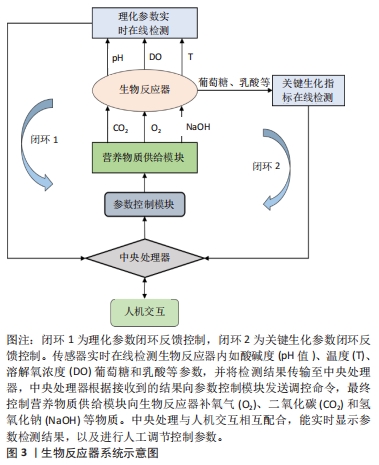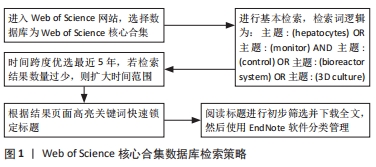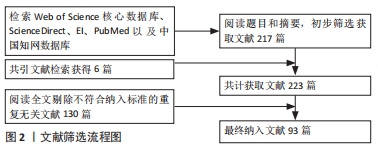[1] ADAY A, O’LEARY JG. Acute on chronic liver failure: definition and implications. Clin Liver Dis. 2020;24(3):521-534.
[2] KAPIKIRAN G, BULBULOGLU S, OZDEMIR A, et al. Knowledge and attitudes on organ donation from the perspective of liver transplant patients. Transplant Proc. 2021;53(1):25-29.
[3] TREBICKA J, SUNDARAM V, MOREAU R, et al. Liver transplantation for acute-on-chronic liver failure: science or fiction? Liver Transpl. 2020;26(7):906-915.
[4] KARVELLAS CJ, SUBRAMANIAN RM. Current evidence for extracorporeal liver support systems in acute liver failure and acute-on-chronic liver failure. Crit Care Clin. 2016;32(3):439-451.
[5] 武之涛,彭青,高毅,等.生物人工肝的研究进展[J].中国细胞生物学学报,2019,41(4):594-600.
[6] HE Y T, QI YN, ZHANG BQ, et al. Bioartificial liver support systems for acute liver failure: a systematic review and meta-analysis of the clinical and preclinical literature. World J Gastroenterol. 2019;25(27):3634-3648.
[7] YOU S, ZHU B, LIU H, et al. Safety of human hepatoma cell-line constructing bioartificial liver supporting system treating patients with liver failure. Hepatogastroenterology. 2014;61(132):933-936.
[8] CHEN S, WANG J, REN H, et al. Hepatic spheroids derived from human induced pluripotent stem cells in bio-artificial liver rescue porcine acute liver failure. Cell Res. 2020;30(1):95-97.
[9] STARK H, ISSA F. An extracorporeal bioartificial liver embedded with 3D-layered human progenitor-like cells relieves acute liver failure in pigs. Transplantation. 2020;104(10):1970.
[10] WANG A, MADDEN LA, PAUNOV VN. Advanced biomedical applications based on emerging 3D cell culturing platforms. J Mater Chem B. 2020; 8(46):10487-10501.
[11] GILBERT DF, MOFRAD SA, FRIEDRICH O, et al. Proliferation characteristics of cells cultured under periodic versus static conditions. Cytotechnology. 2019;71(1):443-452.
[12] LEE HJ, AHN J, JUNG CR, et al. Optimization of 3D hydrogel microenvironment for enhanced hepatic functionality of primary human hepatocytes. Biotechnol Bioeng. 2020;117(6):1864-1876.
[13] OGAWA S, SURAPISITCHAT J, VIRTANEN C, et al. Three-dimensional culture and cAMP signaling promote the maturation of human pluripotent stem cell-derived hepatocytes. Development. 2013;140(15):3285-3296.
[14] LECLERC E, KIMURA K, SHINOHARA M, et al. Comparison of the transcriptomic profile of hepatic human induced pluripotent stem like cells cultured in plates and in a 3D microscale dynamic environment. Genomics. 2017;109(1):16-26.
[15] ELLIS AJ, HUGHES RD, WENDON JA, et al. Pilot-controlled trial of the extracorporeal liver assist device in acute liver failure. Hepatology. 1996; 24(6):1446-1451.
[16] ZHAO DX, CHEN S, CAI J, et al. Derivation and characterization of hepatic progenitor cells from human embryonic stem cells. PLoS One. 2009;4(7):e6468.
[17] SONG Z, CAI J, LIU Y, et al. Efficient generation of hepatocyte-like cells from human induced pluripotent stem cells. Cell Res. 2009;19(11):1233-1242.
[18] SI-TAYEB K, NOTO FK, NAGAOKA M, et al. Highly efficient generation of human hepatocyte–like cells from induced pluripotent stem cells. Hepatology. 2010;51(1):297-305.
[19] HUANG P, ZHANG L, GAO Y, et al. Direct reprogramming of human fibroblasts to functional and expandable hepatocytes. Cell Stem Cell. 2014;14(3):370-384.
[20] LI X, YUAN J, LI W, et al. Direct differentiation of homogeneous human adipose stem cells into functional hepatocytes by mimicking liver embryogenesis. J Cell Physiol. 2014;229(6):801-812.
[21] ZHANG Y, SHI J, LIU S. Establishment and characterization of a telomerase-immortalized sheep trophoblast cell line. Biomed Res Int. 2016;2016:5808575.
[22] WU H, ZHOU X, FU GB, et al. Reversible transition between hepatocytes and liver progenitors for in vitro hepatocyte expansion. Cell Res. 2017;27(5):709-712.
[23] XIE B, SUN D, DU Y, et al. A two-step lineage reprogramming strategy to generate functionally competent human hepatocytes from fibroblasts. Cell Res. 2019;29(9):696-710.
[24] PLUTA KD, SAMLUK A, WENCEL A, et al. Genetically modified C3A cells with restored urea cycle for improved bioartificial liver. Biocybern. Biomed. Eng. 2020;40(1):378-387.
[25] COLLINS DP, HAPKE JH, ARAVALLI RN, et al. Development of immortalized human hepatocyte-like hybrid cells by fusion of multi-lineage progenitor cells with primary hepatocytes. PLoS One. 2020;15(6):e0234002.
[26] 李刚磊,武杰,王斌,等.用于生物人工肝的HepG2、C3A细胞系蛋白合成与代谢功能的比较研究[J].临床医药文献电子杂志,2018,5(42):76-79.
[27] SUSSMAN NL, KELLY JH. Extracorporeal cellular therapy (ELAD) in severe alcoholic hepatitis: a multinational, prospective, controlled, randomized trial. Liver Transpl. 2018;24(5):711.
[28] HURRELL T, LILLEY KS, CROMARTY AD. Proteomic responses of HepG2 cell monolayers and 3D spheroids to selected hepatotoxins. Toxicol Lett. 2019; 300:40-50.
[29] ŠTAMPAR M, BREZNIK B, FILIPIČ M, et al. Characterization of in vitro 3D cell model developed from human hepatocellular carcinoma (HepG2) Cell Line. Cells. 2020;9(12):2557.
[30] XIANG CG, DU YY, MENG GF, et al. Long-term functional maintenance of primary human hepatocytes in vitro. Science. 2019;364(6438):399.
[31] HU H, GEHART H, ARTEGIANI B, et al. Long-term expansion of functional mouse and human hepatocytes as 3D organoids. Cell. 2018;175(6):1591-1606.e19.
[32] ZHANG K, ZHANG L, LIU W, et al. In vitro expansion of primary human hepatocytes with efficient liver repopulation capacity. Cell Stem Cell. 2018; 23(6):806-819.
[33] RAMBOER E, DE CRAENE B, DE KOCK J, et al. Strategies for immortalization of primary hepatocytes. J Hepatol. 2014;61(4):925-943.
[34] 李伟建,王振宇,袁天杰,等.永生化肝脏前体样细胞可用于生物人工肝治疗的研究[J].肝脏,2019,24(8):871-874.
[35] 卢扬洲,黎少,姜华,等.新型永生化人肝细胞系HepZJ的安全性研究[J].药物评价研究,2018,41(6):1062-1067.
[36] 卢扬洲,黎少,姜华,等.永生化人肝细胞HepZJ的临床前急性毒性评价[J].中国组织工程研究,2019,23(13):2067-2074.
[37] DONATO MT, TOLOSA L. Stem-cell derived hepatocyte-like cells for the assessment of drug-induced liver injury. Differentiation. 2019;106:15-22.
[38] CHEN C, SOTO-GUTIERREZ A, BAPTISTA PM, et al. Biotechnology challenges to in vitro maturation of hepatic stem cells. Gastroenterology. 2018;154(5):1258-1272.
[39] SHI D, XIN J, LU Y, et al. Transcriptome profiling reveals distinct phenotype of human bone marrow mesenchymal stem cell-derived hepatocyte-like cells. Int J Med Sci. 2020;17(2):263-273.
[40] DOAN CC, LE TL, HOANG NS, et al. Differentiation of umbilical cord lining membrane-derived mesenchymal stem cells into endothelial-like cells. Iran Biomed J. 2014;18(2):67-75.
[41] HANNOUN Z, STEICHEN C, DIANAT N, et al. The potential of induced pluripotent stem cell derived hepatocytes. J Hepatol. 2016;65(1):182-199.
[42] YAMASHITA T, TAKAYAMA K, SAKURAI F, et al. Billion-scale production of hepatocyte-like cells from human induced pluripotent stem cells. Biochem Biophys Res Commun. 2018;496(4):1269-1275.
[43] FU GB, HUANG WJ, ZENG M, et al. Expansion and differentiation of human hepatocyte-derived liver progenitor-like cells and their use for the study of hepatotropic pathogens. Cell Res. 2019;29(1):8-22.
[44] SUSSMAN NL, KELLY JH. Extracorporeal liver assist in the treatment of fulminant hepatic failure. Blood Purif. 1993;11(3):170-174.
[45] DE BARTOLO L, SALERNO S, CURCIO E, et al. Human hepatocyte functions in a crossed hollow fiber membrane bioreactor. Biomaterials. 2009;30(13): 2531-2543.
[46] XIA L, AROOZ T, ZHANG S, et al. Hepatocyte function within a stacked double sandwich culture plate cylindrical bioreactor for bioartificial liver system. Biomaterials. 2012;33(32):7925-7932.
[47] 杨波,刘宝林,任杰,等.微载体技术肝细胞体外高密度培养的实验[J].应用化工,2015,44(12):2349-2352,2355.
[48] ZHANG R, LIU M. Timed morphological changes of human hepatocytes L-02 cultured at high density by the support of spherical porous chitosan microcarriers. Chin J Tissue Eng Res. 2015;19:1924-1930.
[49] OKUDAIRA T, AMIMOTO N, MIZUMOTO H, et al. Formation of three-dimensional hepatic tissue by the bottom-up method using spheroids. J Biosci Bioeng. 2016;122(2):213-218.
[50] LU J, ZHANG X, LI J, et al. A new fluidized bed bioreactor based on diversion-type microcapsule suspension for bioartificial liver systems. PLoS One. 2016; 11(2):e0147376.
[51] YAJIMA Y, LEE CN, YAMADA M, et al. Development of a perfusable 3D liver cell cultivation system via bundling-up assembly of cell-laden microfibers. J Biosci Bioeng. 2018;126(1):111-118.
[52] LIU W, HU D, GU C, et al. Fabrication and in vitro evaluation of a packed-bed bioreactor based on an optimum two-stage culture strategy. J Biosci Bioeng. 2019;127(4):506-514.
[53] YEKRANGSAFAKAR A, HAMEL KM, MEHRNEZHAD A, et al. Development of rolled scaffold for high-density adherent cell culture. Biomed Microdevices. 2019;22(1):4.
[54] SIBUEA C, PAWITAN J, ANTARIANTO R, et al. 3D Co-culture of hepatocyte, a hepatic stellate cell line, and stem cells for developing a bioartificial liver prototype. Int J Technol. 2020;11:951-962.
[55] PASQUA M, PEREIRA U, MESSINA A, et al. HepaRG self-assembled spheroids in alginate beads meet the clinical needs for bioartificial liver. Tissue Eng Part A. 2020;26(11-12):613-622.
[56] LUCENDO-VILLARIN B, MESEGUER-RIPOLLES J, DREW J, et al. Development of a cost-effective automated platform to produce human liver spheroids for basic and applied research. Biofabrication. 2020;13(1):015009.
[57] LU Z, PRIYA RAJAN SA, SONG Q, et al. 3D scaffold-free microlivers with drug metabolic function generated by lineage-reprogrammed hepatocytes from human fibroblasts. Biomaterials. 2021;269:120668.
[58] OGAWA K, ASONUMA K, INOMATA Y, et al. The efficacy of prevascularization by basic FGF for hepatocyte transplantation using polymer devices in rats. Cell Transplant. 2001;10(8):723-729.
[59] LEE G, KIM H, PARK JY, et al. Generation of uniform liver spheroids from human pluripotent stem cells for imaging-based drug toxicity analysis. Biomaterials. 2021;269:120529.
[60] SIMUTIS R, LüBBERT A. Bioreactor control improves bioprocess performance. Biotechnol J. 2015;10(8):1115-1130.
[61] DE BOURNONVILLE S, LAMBRECHTS T, VANHULST J, et al. Towards self-regulated bioprocessing:a compact benchtop bioreactor system for monitored and controlled 3D cell and tissue culture. Biotechnol J. 2019; 14(7):e1800545.
[62] FEIDL F, VOGG S, WOLF M, et al. Process-wide control and automation of an integrated continuous manufacturing platform for antibodies. Biotechnol Bioeng. 2020;117(5):1367-1380.
[63] HEINS ZJ, MANCUSO CP, KIRIAKOV S, et al. Designing Automated, High-throughput, Continuous Cell Growth Experiments Using eVOLVER. J Vis Exp. 2019. doi: 10.3791/59652.
[64] 吴昌哲,李柯,霍小林.用于生物人工肝的细胞规模化培养系统的研制[A].第九届全国疑难及重症肝病大会论文集[C].2017:1.
[65] 李伟建,杨秋蕊,王振宇,等.生物人工肝的研究现状与进展[J].肝脏, 2018,23(1):80-83.
[66] PIGEAU GM, CSASZAR E, DULGAR-TULLOCH A. Commercial scale manufacturing of allogeneic cell therapy. Front Med. 2018;5:233.
[67] GUERRA A, VON STOSCH M, GLASSEY J. Toward biotherapeutic product real-time quality monitoring. Crit Rev Biotechnol. 2019;39(3):289-305.
[68] FLINCK M, KRAMER SH, PEDERSEN SF. Roles of pH in control of cell proliferation. Acta Physiol. 2018;223(3):e13068.
[69] 李睿瑜,李明,刘剑峰,等.生物人工肝体外支持系统供氧问题的研究[J].现代科学仪器,2007(6):49-52.
[70] DEMUTH C, VARONIER J, JOSSEN V, et al. Novel probes for pH and dissolved oxygen measurements in cultivations from millilitre to benchtop scale. Appl Microbiol Biotechnol. 2016;100(9):3853-3863.
[71] ZHAO L, FU HY, ZHOU W, et al. Advances in process monitoring tools for cell culture bioprocesses. Eng Life Sci. 2015;15(5):459-468.
[72] GE X, HANSON M, SHEN H, et al. Validation of an optical sensor-based high-throughput bioreactor system for mammalian cell culture. J Biotechnol. 2006;122(3):293-306.
[73] KATTIPPARAMBIL RAJAN D, PATRIKOSKI M, VERHO J, et al. Optical non-contact pH measurement in cell culture with sterilizable, modular parts. Talanta. 2016;161:755-761.
[74] MICHL J, PARK KC, SWIETACH P. Evidence-based guidelines for controlling pH in mammalian live-cell culture systems. Commun Biol. 2019;2(1):144.
[75] 段梅梅,霍小林,吴昌哲,等.生物人工肝支持系统中溶解氧控制问题的研究进展[J].中国生物医学工程学报,2011,30(3):462-467.
[76] 刘剑峰,宋涛,王喆,等.圆柱状人工肝生物反应器中溶解氧浓度动态分布模型及其氧浓度变化速率[J].过程工程学报,2010,10(1):10-16.
[77] 刘剑峰,李明,杨巍,等.新型生物人工肝支持系统的控制与实现[J].生物医学工程学杂志,2008,25(2):445-449.
[78] 王春晨. 细胞培养气体混合控制系统研究[D].北京:解放军军事科学院, 2018.
[79] DOWNEY BJ, GRAHAM LJ, BREIT JF, et al. A novel approach for using dielectric spectroscopy to predict viable cell volume (VCV) in early process development. Biotechnol Prog. 2014;30(2):479-487.
[80] METZE S, RUHL S, GRELLER G, et al. Monitoring online biomass with a capacitance sensor during scale-up of industrially relevant CHO cell culture fed-batch processes in single-use bioreactors. Bioprocess Biosyst Eng. 2020; 43(2):193-205.
[81] ISIDRO IA, VICENTE P, PAIS DAM, et al. Online monitoring of hiPSC expansion and hepatic differentiation in 3D culture by dielectric spectroscopy. Biotechnol Bioeng. 2021. doi: 10.1002/bit.27751.
[82] SCHMID J, SCHWARZ S, MEIER-STAUDE R, et al. A perfusion bioreactor system for cell seeding and oxygen-controlled cultivation of three-dimensional cell cultures. Tissue Eng Part C Methods. 2018;24(10):585-595.
[83] RENNEBERG R, TROTT-KRIEGESKORTE G, LIETZ M, et al. Enzyme sensor-FIA-system for on-line monitoring of glucose, lactate and glutamine in animal cell cultures. J Biotechnol. 1991;21(1):173-185.
[84] TRIC M, LEDERLE M, NEUNER L, et al. Optical biosensor optimized for continuous in-line glucose monitoring in animal cell culture. Anal Bioanal Chem. 2017;409(24):5711-5721.
[85] PONTIUS K, SEMENOVA D, SILINA YE, et al. Automated electrochemical glucose biosensor platform as an efficient tool toward on-line fermentation monitoring:novel application approaches and insights. Front Bioeng Biotechnol. 2020;8:436.
[86] ADAMS AG, BULUSU RKM, MUKHITOV N, et al. Online measurement of glucose consumption from HepG2 cells using an integrated bioreactor and enzymatic assay. Anal Chem. 2019;91(8):5184-5190.
[87] WELTIN A, HAMMER S, NOOR F, et al. Accessing 3D microtissue metabolism: lactate and oxygen monitoring in hepatocyte spheroids. Biosens Bioelectron. 2017;87:941-948.
[88] WU C, CAO Y, HUO X, et al. Simulation and experimental research on micro-channel for detecting cell status in bio-artificial liver. Technol Health Care. 2015;23 Suppl 2:S365-S371.
[89] BHATIA H, MEHDIZADEH H, DRAPEAU D, et al. In-line monitoring of amino acids in mammalian cell cultures using raman spectroscopy and multivariate chemometrics models. Eng Life Sci. 2018;18(1):55-61.
[90] MROSS S, ZIMMERMANN T, WINKIN N, et al. Integrated multi-sensor system for parallel in-situ monitoring of cell nutrients, metabolites, cell density and pH in biotechnological processes. Sens Actuators B. 2016;236:937-946.
[91] 许诗晨,吴昌哲,张广浩,等.用于生物型人工肝脏支持系统的肝细胞状态检测及应用进展[J].生物医学工程学杂志,2018,35(1):151-155.
[92] OTSUJI TOMOMI G, BIN J, YOSHIMURA A, et al. A 3D sphere culture system containing functional polymers for large-scale human pluripotent stem cell production. Stem Cell Rep. 2014;2(5):734-745.
[93] 杨嘉屹,张广浩,张丞,等.干细胞扩增及肝向分化过程中相关指标及其检测方法[J].中国组织工程研究,2020,24(25):4039-4045.
|
